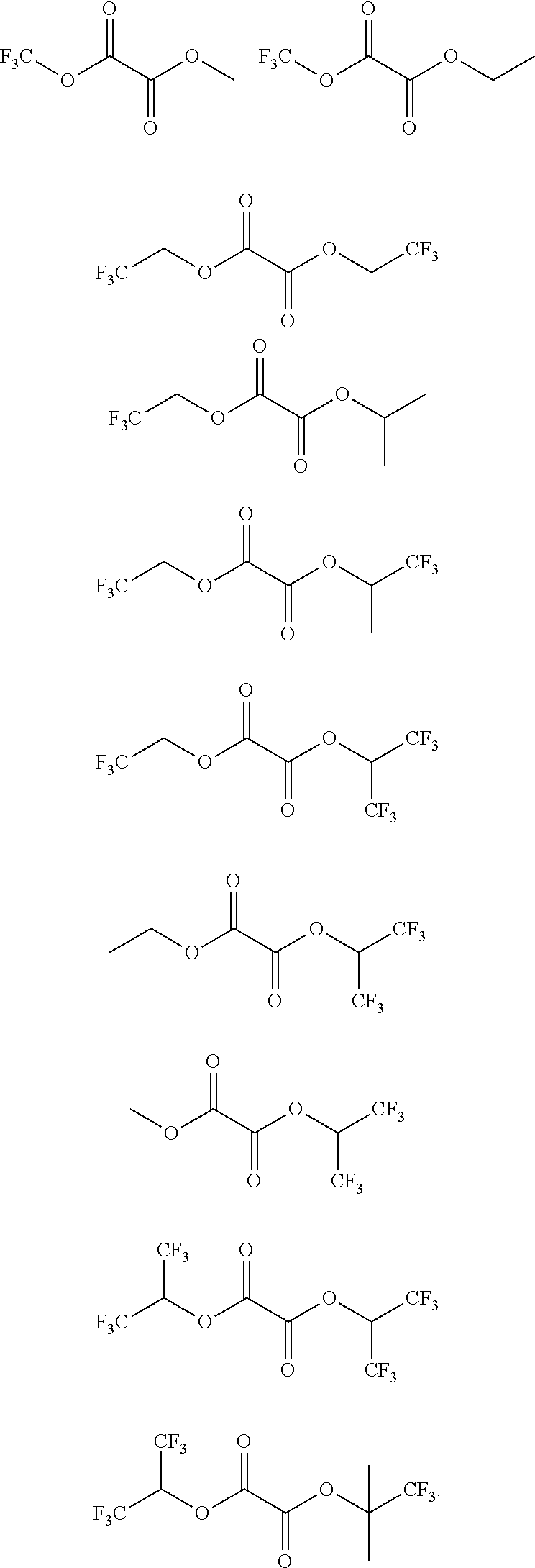Lithium secondary battery electrolyte and lithium secondary battery comprising same
a secondary battery and electrolyte technology, applied in the field of lithium secondary batteries, can solve the problems of affecting the stability reduction, the stability reduction occurs, and the swelling phenomenon of the battery, and achieves excellent high-temperature storage characteristics, excellent capacity recovery rate, and reduced swelling.
- Summary
- Abstract
- Description
- Claims
- Application Information
AI Technical Summary
Benefits of technology
Problems solved by technology
Method used
Image
Examples
preparation example 1
Synthesis of bis(2,2,2-trifluoroethyl) oxalate (hereinafter, referred to as PEA46)
[0085]
[0086]2,2,2-trifluoro ethanol (10.5 g) and triethylamine (10.6 g) were put into dichloromethane (100 mL) under nitrogen atmosphere, and stirred at 0° C. for 30 minutes. Oxalyl chloride (6.35 g) was slowly added dropwise to the cooled solution for 30 minutes, and the reaction solution was stirred at room temperature for 2 hours. An organic solution was washed with 1N hydrochloric acid aqueous solution (50 mL) two times, and washed with saturated sodium bicarbonate aqueous solution (50 mL) two times. The washed organic layer was dried by adding anhydrous magnesium sulfate, and filtered to remove magnesium sulfate, and distilled under reduced pressure to obtain bis(2,2,2-trifluoroethyl)oxalate (8.89 g).
[0087]1H NMR (CDCl3, 500 MHz): δ 4.67 (q, J=8.0 Hz, 4H)
preparation example 2
Synthesis of bis(1,1,1,3,3,3-hexafluoro-2-propyl) oxalate (hereinafter, referred to as PEA53
[0088]
[0089]1,1,1,3,3,3-hexafluoro-2-propanol (17.6 g) and triethylamine (10.6 g) were put into diethyl ether (100 mL) under nitrogen atmosphere, and stirred at 0° C. for 30 minutes. Oxalyl chloride (6.35 g) was slowly added dropwise to the cooled solution for 30 minutes, and the reaction solution was stirred at room temperature for 2 hours. The solution was filtered to remove a solid, and the filtered solution was distilled under reduced pressure to obtain bis(1,1,1,3,3,3-hexafluoro-2-propyl)oxalate (9.75 g).
[0090]1H NMR (CDCl3, 500 MHz): δ 5.81 (heptet, J=5.5 Hz, 2H).
preparation example 3
Synthesis of dimethyl oxalate (hereinafter, referred to as PEA35)
[0091]
[0092]Methanol (3.36 g) and triethylamine (10.6 g) were put into dichloromethane (100 mL) under nitrogen atmosphere, and stirred at 0° C. for 30 minutes. Oxalyl chloride (6.35 g) was slowly added dropwise to the cooled solution for 30 minutes, and the reaction solution was stirred at room temperature for 2 hours. An organic solution was washed with 1N hydrochloric acid aqueous solution (50 mL) two times, and washed with saturated sodium bicarbonate aqueous solution (50 mL) two times. The washed organic layer was dried by adding anhydrous magnesium sulfate, and filtered to remove magnesium sulfate. A solvent of the filtered solution was removed by distillation under reduced pressure, and the obtained solution was recrystallized with diethyl ether and petroleum ether, to obtain dimethyl oxalate (4.13 g).
[0093]1H NMR (CDCl3, 500 MHz): δ 3.58 (s, 6H)
PUM
| Property | Measurement | Unit |
|---|---|---|
| voltage | aaaaa | aaaaa |
| temperature | aaaaa | aaaaa |
| crystallite size | aaaaa | aaaaa |
Abstract
Description
Claims
Application Information
 Login to View More
Login to View More - R&D
- Intellectual Property
- Life Sciences
- Materials
- Tech Scout
- Unparalleled Data Quality
- Higher Quality Content
- 60% Fewer Hallucinations
Browse by: Latest US Patents, China's latest patents, Technical Efficacy Thesaurus, Application Domain, Technology Topic, Popular Technical Reports.
© 2025 PatSnap. All rights reserved.Legal|Privacy policy|Modern Slavery Act Transparency Statement|Sitemap|About US| Contact US: help@patsnap.com



